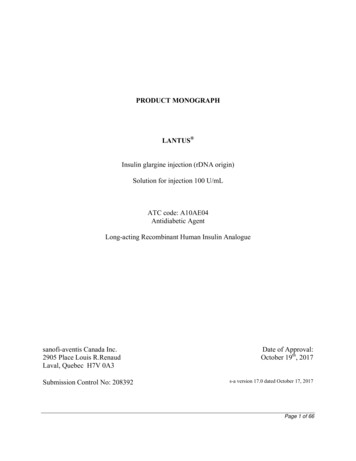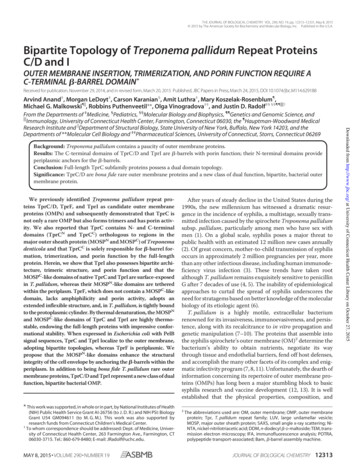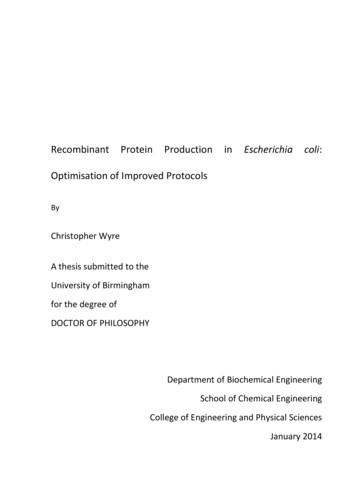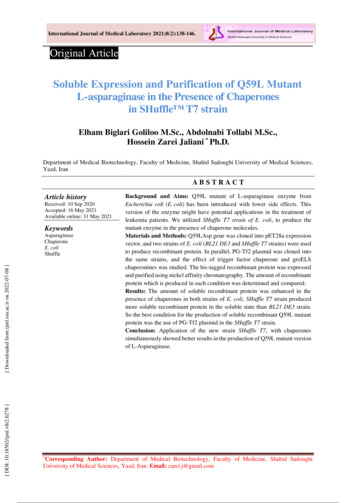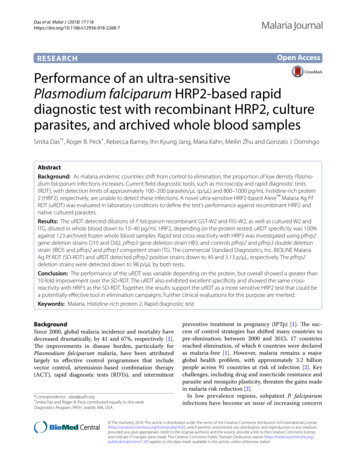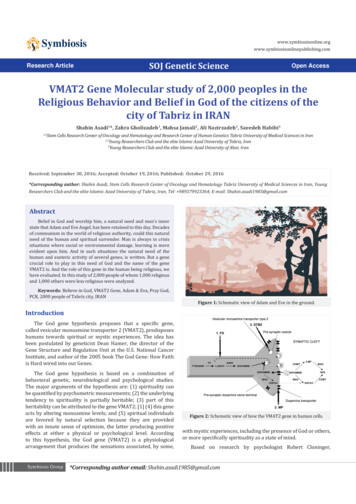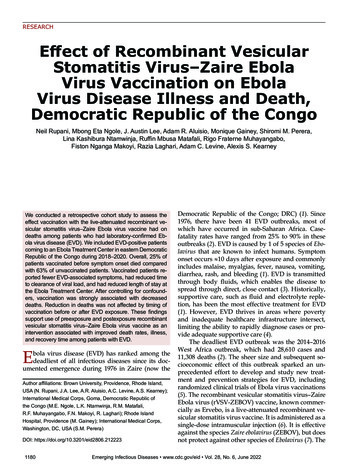
Transcription
RESEARCHEffect of Recombinant VesicularStomatitis Virus–Zaire EbolaVirus Vaccination on EbolaVirus Disease Illness and Death,Democratic Republic of the CongoNeil Rupani, Mbong Eta Ngole, J. Austin Lee, Adam R. Aluisio, Monique Gainey, Shiromi M. Perera,Lina Kashibura Ntamwinja, Ruffin Mbusa Matafali, Rigo Fraterne Muhayangabo,Fiston Nganga Makoyi, Razia Laghari, Adam C. Levine, Alexis S. KearneyWe conducted a retrospective cohort study to assess theeffect vaccination with the live-attenuated recombinant vesicular stomatitis virus–Zaire Ebola virus vaccine had ondeaths among patients who had laboratory-confirmed Ebola virus disease (EVD). We included EVD-positive patientscoming to an Ebola Treatment Center in eastern DemocraticRepublic of the Congo during 2018–2020. Overall, 25% ofpatients vaccinated before symptom onset died comparedwith 63% of unvaccinated patients. Vaccinated patients reported fewer EVD-associated symptoms, had reduced timeto clearance of viral load, and had reduced length of stay atthe Ebola Treatment Center. After controlling for confounders, vaccination was strongly associated with decreaseddeaths. Reduction in deaths was not affected by timing ofvaccination before or after EVD exposure. These findingssupport use of preexposure and postexposure recombinantvesicular stomatitis virus–Zaire Ebola virus vaccine as anintervention associated with improved death rates, illness,and recovery time among patients with EVD.Ebola virus disease (EVD) has ranked among thedeadliest of all infectious diseases since its documented emergence during 1976 in Zaire (now theAuthor affiliations: Brown University, Providence, Rhode Island,USA (N. Rupani, J.A. Lee, A.R. Aluisio, A.C. Levine, A.S. Kearney);International Medical Corps, Goma, Democratic Republic ofthe Congo (M.E. Ngole, L.K. Ntamwinja, R.M. Matafali,R.F. Muhayangabo, F.N. Makoyi, R. Laghari); Rhode IslandHospital, Providence (M. Gainey); International Medical Corps,Washington, DC, USA (S.M. Perera)DOI: ic Republic of the Congo; DRC) (1). Since1976, there have been 41 EVD outbreaks, most ofwhich have occurred in sub-Saharan Africa. Casefatality rates have ranged from 25% to 90% in theseoutbreaks (2). EVD is caused by 1 of 5 species of Ebolavirus that are known to infect humans. Symptomonset occurs 10 days after exposure and commonlyincludes malaise, myalgias, fever, nausea, vomiting,diarrhea, rash, and bleeding (1). EVD is transmittedthrough body fluids, which enables the disease tospread through direct, close contact (3). Historically,supportive care, such as fluid and electrolyte repletion, has been the most effective treatment for EVD(1). However, EVD thrives in areas where povertyand inadequate healthcare infrastructure intersect,limiting the ability to rapidly diagnose cases or provide adequate supportive care (4).The deadliest EVD outbreak was the 2014–2016West Africa outbreak, which had 28,610 cases and11,308 deaths (2). The sheer size and subsequent socioeconomic effect of this outbreak sparked an unprecedented effort to develop and study new treatment and prevention strategies for EVD, includingrandomized clinical trials of Ebola virus vaccinations(5). The recombinant vesicular stomatitis virus–ZaireEbola virus (rVSV-ZEBOV) vaccine, known commercially as Ervebo, is a live-attenuated recombinant vesicular stomatitis virus vaccine. It is administered as asingle-dose intramuscular injection (6). It is effectiveagainst the species Zaire ebolavirus (ZEBOV), but doesnot protect against other species of Ebolavirus (7). TheEmerging Infectious Diseases www.cdc.gov/eid Vol. 28, No. 6, June 2022
rVSV-ZEBOV Vaccination and EVDrVSV-ZEBOV vaccine was initially administered inGuinea under emergency use authorization by theUS Food and Drug Administration (FDA) and in DRCunder compassionate use by the World Health Organization (WHO) (8,9).Multiple clinical trials have demonstrated thatthe rVSV-ZEBOV vaccine is well tolerated without serious adverse events. However, many vaccine recipients report self-limiting systemic symptoms, including fever, headache, myalgias, and fatigue, within thefirst 24 hours after vaccination. Symptoms caused byreactogenicity mimic the first symptoms of EVD; thisreaction is essential to consider, particularly in outbreak settings, because recipients are often vaccinatedafter a potential EVD exposure. Vaccine recipientshave also reported delayed side effects, includingpolyarthralgia, polyarticular arthritis, and skin eruptions in the first 2–3 weeks after vaccination (10–12).Clinical trials have demonstrated that the vaccine ishighly immunogenic, elicits immune responses thatare largely maintained over a 12-month period, and ishighly effective at preventing EVD (10,13–15).On August 1, 2018, the DRC Ministry of Healthdeclared its 10th EVD outbreak, which became thesecond deadliest in history, resulting in 3,481 casesand 2,299 deaths (2,9). The Zaire ebolavirus species wasidentified as the cause of the outbreak (16). A ringvaccination strategy was implemented to administerrVSV-ZEBOV vaccine during this outbreak, targetingcontacts of cases, contacts of contacts, and healthcareworkers (9). Many persons were vaccinated postexposure. Other persons might have received preexposure vaccination, particularly if they were identifiedas contacts of contacts. In late 2019, rVSV-ZEBOVvaccine was prequalified by WHO and approved foruse in persons 18 years of age by the FDA (17,18). Todate, 350,000 persons have received rVSV-ZEBOVvaccine in Guinea and the DRC (2). Although studieshave demonstrated the vaccine is safe and effective,WHO states that further research is needed to support its full licensure (19).A major remaining question is whether rVSVZEBOV vaccine can reduce illness and death forpatients who have confirmed EVD, in addition topreventing infection. Other vaccines, such as thosedirected against pertussis, varicella, and rotavirus,have evidence supporting reduced illness, death,and disease severity in patients experiencing breakthrough infections (20,21). More recently, vaccination against SARS-CoV-2 with authorized mRNAvaccines has demonstrated reduced viral load, lower risk for febrile symptoms, and shorter durationof symptoms among persons experiencing break-through infections (22). Furthermore, some vaccineshave been shown to provide protection when administered after exposure. Examples include measles,rabies, hepatitis A and B, and varicella vaccines (20).The purpose of our study was to determine the effectthat vaccination with rVSV-ZEBOV has on clinicalcharacteristics and outcomes among patients withlaboratory-confirmed EVD.MethodsStudy Design, Setting, and PopulationWe conducted a retrospective cohort study of patientswho came for care at the International Medical CorpsMangina Ebola Treatment Center (ETC) during the2018 EVD outbreak in the DRC. The eastern provinces of the DRC (North Kivu and Ituri) served as themain catchment area for the Mangina ETC, located inNorth Kivu. All persons who came to the ManginaETC during December 7, 2018–January 29, 2020, whohad laboratory-confirmed diagnosis of EVD were eligible for inclusion in this study. Persons were excluded if they did not have a documented EVD outcome(death or survival), if the patient’s vaccination statuswas unknown, or if they did not have a reported dateof symptom onset (Figure 1). The Institutional ReviewBoard at Rhode Island Hospital (Lifespan Health System, Providence, RI, USA) provided ethics exemptionfor this study and waived the requirement to obtaininformed consent.Laboratory DiagnosisAll patients had laboratory testing conducted by theInstitut National de Recherche Biomédicale (Kinshasa-Bombe, DRC). The Cepheid GeneXpert Ebola Assay (https://www.cepheid.com) was used for detection of ZEBOV RNAs encoding surface glycoproteinand nucleoprotein. The assay was also used to determine the cycle threshold (Ct), a proxy for viral load(23,24). The Ct value is inversely proportional to viralload; a Ct value 40 was considered negative for cases. A reverse transcription PCR was used to confirmEVD cases.Study ProceduresResponse teams were deployed to health zones inNorth Kivu, South Kivu, and Ituri Provinces in theeastern part of DRC to identify suspected, confirmed,or probable cases of EVD. Suspected and confirmedcase-patients were isolated and transported to ETCsfor further testing and treatment. Patients could alsoself-present to the ETC. All patients were screened bytrained clinical staff to ensure they met the clinicalEmerging Infectious Diseases www.cdc.gov/eid Vol. 28, No. 6, June 20221181
RESEARCHDuring triage at the ETC, detailed information was collected about each patient on standardized clinical forms, which included demographics,symptoms, potential contact with a suspected orconfirmed EVD individual, comorbidities, and selfreported Ebola vaccination status. During ETC admission, protocol based care was provided. Patientswere discharged from the ETC after 2 consecutivenegative laboratory test results. The Mangina ETCalso served as a PALM Trial site (Pamoja TulindeMaisha [Together Save Lives in Kiswahili]), in whichpatients were randomized to receive experimentaltherapeutics (29). Additional detailed informationabout the clinical care provided at the ETC is provided 1.pdf).Data ManagementData were retrospectively abstracted from clinicaldocumentation by independent trained study personnel blinded to the specific study aims and entered intoa standardized digital database. Additional information on data management is provided (Appendix).Statistical Methods and VariablesFigure 1. Inclusion/exclusion algorithm and makeup of studysample for study of impact of recombinant vesicular stomatitisvirus–Zaire Ebola virus vaccination on EVD illness and death,Democratic Republic of the Congo. EVD, Ebola virus disease.case definition for suspected or confirmed EVD basedon WHO and Médecins Sans Frontières guidelines,in consultation with local health authorities (25,26).Patients who had a previously confirmed laboratorydiagnosis of EVD were directly admitted to the confirmed ward. Patients who met the case definitionfor suspected EVD were admitted to the ETC suspectward, in which blood samples were drawn for initialEVD testing. If the initial test result of the patient wasnegative, they remained in the ETC until 72 hourshad passed since symptom onset, at which point asecond test was performed. Patients with a positivetest result at that point were considered EVD positiveand moved to the confirmed ward for further management (27,28). All patients who died during admission to the suspect ward or were dead on arrival tothe ETC had an oral swab specimen taken for PCRtesting before being moved to the morgue.1182We performed data analyses by using R Studioversion 4.0.2 (30). We used a Pearson χ2 test anda Fisher exact test to measure association betweencategorical variables and the Wilcoxon rank-sumtest for continuous variables. Significance wasestablished at p value 0.05. We used a case-centered, multivariable logistic regression and theCox Proportional-Hazards model to examine theassociation between previous vaccination withrVSV-ZEBOV (exposure of interest) and the primary outcome of facility-based death (31). Modelscontrolled for potential confounders including age,sex, time between symptom onset and admission tothe ETC, treatment with experimental therapeuticagents, and Ct value (inversely proportional to viral load). We incorporated age2 into models to control for the quadratic relationship between age andsurvival for EVD patients (32).One variable included in our models accountedfor the experimental therapeutics patients received.Previous research has demonstrated that, of the 4potential therapeutics administered at the ETC, 2 ofthese treatments (monoclonal antibody [mAb] 114,a single mAb; and REGN-EB3, a triple mAb) aremore effective against EVD than the other 2 treatments (Zmapp, a triple mAb; and Remdesivir, anantiviral agent) (29). As a result, this variable wascategorized on the basis of whether the patientEmerging Infectious Diseases www.cdc.gov/eid Vol. 28, No. 6, June 2022
rVSV-ZEBOV Vaccination and EVDreceived mAb114 or REGN-EB3, Zmapp or Remdesivir, or no therapeutics.Additional posthoc analysis explored the effectvaccination timing had on deaths. We used the CoxProportional-Hazards model to analyze this relationship. In previous vaccine efficacy studies, EVD caseswith a symptom onset 10 days from randomizationwere included in the analyses. This categorical cutoffwas chosen to account for the incubation period forEVD (33,34), time between symptom onset and laboratory confirmation, and the unknown period of timebetween vaccination and vaccine-induced protectiveimmunity (15). The typical incubation period for EVDis 10 days after exposure to the disease, although datasuggest that it might be shorter for children (33,34).Therefore, in our subanalysis, we used vaccination 10 days before symptom onset as the categorical cutoff. We also used vaccination at 7 and 14 days beforesymptom onset as cutoffs in a sensitivity analysis. Inaddition, although we excluded persons who werevaccinated after symptom onset from our initial analysis, we conducted a separate sensitivity analysis examining the effect vaccination had on deaths withinthis smaller group.ResultsCharacteristics of Study ParticipantsOf the 3,104 persons admitted to the Mangina ETCduring December 7, 2018–January 29, 2020, a total of403 patients had laboratory-confirmed EVD. Of those,385 patients had sufficient data for analysis; 137(35.6%) had been vaccinated before onset of symptoms. An additional 8 patients were vaccinated aftersymptom onset; these patients were excluded fromthe initial analysis (Figure 1).We outlined the similarities and differences between the unvaccinated and vaccinated groups (Table1). Among EVD-confirmed case-patients, a larger proportion of unvaccinated persons were female (63.3%)than male (36.7%) (p 0.018). Vaccinated patientscame to the ETC earlier in their disease course thanunvaccinated patients (2 vs. 5 days after symptom onset; p 0.001), were older (median age 28.0 years vs.25.5 years; p 0.044), and were more likely to havereported contact with a suspected or confirmed EVDpositive person (65.7% vs. 52.4%; p 0.001).Although the rVSV-ZEBOV vaccine is FDA approved for use in persons 18 years of age, someTable 1. Patient characteristics for study of the effect of recombinant vesicular stomatitis virus–Zaire Ebola virus vaccination on Ebolavirus disease illness and death, Democratic Republic of the Congo*CharacteristicOverall, n 385Not vaccinated, n 248Vaccinated, n 137p value†Age, y26.0 (18.0‒40.0)25.5 (12.0‒40.0)28.0 (20.0‒40.0)0.044 549 (12.7)43 (17.3)6 (4.4)0.0015‒1534 (8.8)26 (10.5)8 (5.8)16‒25101 (26.2)55 (22.2)46 (33.6)26‒3588 (22.9)54 (21.8)34 (24.8)36‒4538 (9.9)19 (7.6)19 (13.9)46‒5541 (10.7)27 (10.9)14 (10.2) 5534 (8.8)24 (9.7)10 (7.3)Sex0.018M159 (41.3)91 (36.7)68 (49.6)F226 (58.7)157 (63.3)69 (50.4)Province0.002North Kivu235 (61.0)142 (57.3)93 (67.9)Ituri142 (36.9)104 (41.9)38 (27.7)Unknown8 (2.1)2 (0.8)6 (4.4)Known or suspected Ebola contact 0.001No73 (19.0)62 (25.0)11 (8.0)Yes220 (57.1)130 (52.4)90 (65.7)Unknown92 (23.9)56 (22.6)36 (26.3)Days between symptom onset and admission, d4.0 (2.0‒6.0)5.0 (3.0‒7.0)2.0 (1.0‒4.0) 0.001First cycle threshold value21.6 (18.2‒26.2)20.4 (17.7‒24.2)24.6 (19.9‒28.1) 0.001Therapeutic received0.005None65 (16.9)53 (21.4)12 (8.8)Zmapp or Remdesivir76 (19.7)46 (18.5)30 (21.9)mAb114 or REGN-EB3244 (63.4)149 (60.1)95 (69.3)Final outcome 0.001Died191 (49.6)157 (63.3)34 (24.8)Survived194 (50.4)91 (36.7)103 (75.2)Length of stay among survivors, d21.0 (18.0‒26.0), n 22.0 (19.0‒28.5), n 91 20.0 (17.0‒23.8), n 0.004193102*Values are median (IQR) or no. (%) . IQR, interquartile range; MAb, monoclonal antibody.†Statistical tests were performed by using the Wilcoxon rank sum test, the Pearson 2 test, and the Fisher exact test. Boldface indicates a significantdifference (p 0.05).Emerging Infectious Diseases www.cdc.gov/eid Vol. 28, No. 6, June 20221183
RESEARCHchildren received the vaccine through investigativeprotocols. A larger proportion of vaccinated patients were from North Kivu Province (67.9%) thanfrom Ituri Province (27.7%) (p 0.002). A total of 16(10.2%) unvaccinated women were pregnant, and10 (14.5%) vaccinated women were pregnant. Vaccinated persons were more likely to receive mAb114 orREGN-EB3 than were unvaccinated persons (69.3%vs. 60.1%). We provide additional information aboutspecific anti-EBOV treatments stratified by vaccination timing. (Appendix Table 1).EVD-Associated Clinical FindingsA greater proportion of unvaccinated patients experienced EVD-associated symptoms than did vaccinatedpatients. These symptoms included nausea, diarrhea,asthenia, anorexia, abdominal pain, chest pain, myalgia, dyspnea, dysphagia, sore throat, conjunctivitis,and bleeding (Table 2).Diagnostic Testing and Time to First Negative Test ResultVaccinated patients had a lower viral load, as indicated by a higher Ct value, than did unvaccinatedpatients (24.6 vs. 20.4; p 0.001) (Table 1). Amongthose who survived (n 144), vaccinated patientscleared the virus more rapidly than did unvaccinated patients; this relationship was statistically significant and persisted when the data were analyzedusing the date of symptom onset, first positive testresult date, or date of admission to the ETC as thestarting point (Figure 2; Appendix Figures 1, 2). Unvaccinated survivors of EVD also spent more time atthe ETC than did vaccinated survivors (22.0 days vs.20.0 days; p 0.004).DeathsOverall, 24.8% of vaccinated patients died, comparedwith 63.3% of unvaccinated patients (p 0.001). Previous vaccination with rVSV-ZEBOV was associatedwith decreased likelihood of death compared withthose unvaccinated (odds ratio 0.19, 95% CI 0.12–0.30;p 0.001). This relationship persisted after controllingfor potential confounders (adjusted odds ratio 0.26,95% CI 0.15–0.46; p 0.001).We used the Cox Proportional-Hazards model todetermine the relationship between vaccination anddeath among all patients who had EVD symptom onset. After controlling for potential confounders, wefound that vaccination remained a major predictor ofreduced deaths for these patients (adjusted hazard ratio [aHR] 0.38, 95% CI 0.25–0.56) (Figure 3).We also explored the relationship between timingof vaccination and death by using the Cox Proportional-Hazards Model for different subsets of all patientswho were vaccinated. Models controlled for potential confounders. Vaccination with rVSV-ZEBOV reduced the risk for death in those vaccinated 10 daysbefore symptom onset (aHR 0.41, 95% CI 0.23–0.73;p 0.002) and in those vaccinated 10 days beforesymptom onset (aHR 0.34, 95% CI 0.21–0.55; p 0.001)Table 2. Frequency of symptoms reported by vaccinated and unvaccinated Ebola virus disease‒confirmed patients, DemocraticRepublic of the CongoSymptomNot vaccinated, n 248, No. (%)Vaccinated, n 137, no. (%)p value*Asthenia†214 (86.6)102 (74.5)0.004Anorexia204 (82.3)80 (58.4) 0.001Fever193 (77.8)99 (72.3)0.273Headache†156 (63.2)90 (65.7)0.700Abdominal pain152 (61.3)56 (40.9) 0.001Nausea140 (56.5)50 (36.5) 0.001Conjunctivitis†138 (55.9)49 (35.8) 0.001Diarrhea†137 (55.5)45 (32.8) 0.001Arthralgia134 (54.0)74 (54.0)1.000Myalgia128 (51.6)54 (39.4)0.029Chest pain†89 (36.0)32 (23.4)0.014Cough†75 (30.4)36 (26.3)0.466Bleeding‡67 (27.1)14 (10.3) 0.001Dysphagia61 (24.6)17 (12.4)0.007Sore throat†52 (21.1)17 (12.4)0.048Dyspnea†47 (19.0)13 (9.5)0.020Coma‡16 (6.5)2 (1.5)0.050Confusion‡14 (5.7)2 (1.5)0.090Rash‡14 (5.7)5 (3.7)0.540Hiccup‡14 (5.7)3 (2.2)0.188Jaundice†12 (4.9)2 (1.5)0.156Photophobia†5 (2.0)1 (0.7)0.588*Boldface indicates a significant difference (p 0.05).†One patient had missing data for this symptom.‡Two patients had missing data for this symptom.1184Emerging Infectious Diseases www.cdc.gov/eid Vol. 28, No. 6, June 2022
rVSV-ZEBOV Vaccination and EVDwhen compared with those unvaccinated. We developed a Kaplan-Meier curve for these data (AppendixFigure 3). These relationships persisted when usingvaccination at 7 days and 14 days before symptomonset as cutoffs. Moreover, among those vaccinated 10 days before symptom onset, the specific numberof days between vaccination and symptom onset wasnot a significant predictor of risk for death. This resultwas also true for those vaccinated 10 days beforesymptom onset.We also explored the relationship between timingof vaccination and death by using the Cox Proportional-Hazards Model for different subsets of all patientswho were vaccinated. Models controlled for potential confounders. Vaccination with rVSV-ZEBOV reduced the risk for death in those vaccinated 10 daysbefore symptom onset (aHR 0.41, 95% CI 0.23–0.73;p 0.002) and in those vaccinated 10 days beforesymptom onset (aHR 0.34, 95% CI 0.21–0.55; p 0.001)when compared with those unvaccinated. We developed a Kaplan-Meier curve for these data (AppendixFigure 3). These relationships persisted when usingvaccination at 7 days and 14 days before symptomonset as cutoffs. Moreover, among those vaccinated 10 days before symptom onset, the specific numberof days between vaccination and symptom onset wasnot a significant predictor of risk for death. This resultwas also true for those vaccinated 10 days beforesymptom onset.An additional 8 persons were vaccinated aftersymptom onset. Although these patients were notincluded in the larger analysis, we used the Cox Proportional-Hazards model to assess the effect of vaccine administration after symptom onset on death.The association between death and vaccination aftersymptom onset was not statistically significant (HR0.22, 95% CI 0.03–1.61; p 0.138).DiscussionIn this study, we found that both preexposure andpostexposure vaccination with rVSV-ZEBOV wasassociated with a reduction in EVD symptoms anddeaths in laboratory-confirmed, EVD-positive patients. Vaccinated patients had a lower viral load uponadmission and had fewer EVD-associated symptomsoverall than their unvaccinated counterparts. Vaccinated persons were slightly older and more likely tohave reported contact with a suspected or confirmedEVD-positive person. Unvaccinated persons weremore likely to be female. Vaccinated persons alsocame to the ETC earlier in their disease course thanunvaccinated patients, which might suggest that thispopulation is more able or willing to engage with theFigure 2. Days to first negative test result since symptom onsetamong patients who survived, stratified by vaccination status,n 144, for impact of recombinant vesicular stomatitis virus–Zaire Ebola virus vaccination on Ebola virus disease illness anddeath, Democratic Republic of the Congo. Horizontal lines withinboxes indicate medians; error bars indicate interquartile ranges,p 0.0001, by Wilcoxon rank sum test.healthcare system or to follow recommended healthguidelines. Accepting the vaccine suggests moreknowledge about the disease itself and is a positivehealth-seeking behavior; both of these factors mightprompt such a person to seek care earlier. Increasedknowledge of a disease has also been associated withincreased vaccine uptake for other illnesses, including SARS-CoV-2 (35,36).The willingness of vaccinated patients to seekcare earlier in the disease course enabled treatmentto be initiated earlier, which might have preventedtheir illness from becoming as severe as it otherwiseFigure 3. Kaplan-Meier survival plot of patients with Ebolavirus disease, stratified by vaccination status, for study of effectof recombinant vesicular stomatitis virus–Zaire Ebola virusvaccination on Ebola virus disease illness and death, DemocraticRepublic of the Congo. Numbers below chart indicate number of illpatients at that time point, excluding patients who had died or whorecovered and were discharged. One patient in the vaccinatedgroup was excluded from this analysis because that patient didnot have a reported date of discharge.Emerging Infectious Diseases www.cdc.gov/eid Vol. 28, No. 6, June 20221185
RESEARCHmight have been. Persons enrolled in the PALM Trial demonstrated similar behavior trends (29). Vaccinated persons were more likely to enroll in the trialsooner after the onset of symptoms, which, the authors concluded, might suggest a possible positiverelationship between vaccination status and healthseeking behaviors. Data from the PALM Trial alsohighlight the need for initiation of treatment withmAb114 or REGN-EB3 early in the disease course.The authors observed an 11% increase in the oddsof death for each additional day that symptoms persisted before enrollment in the study (29). In ourstudy population, vaccinated persons were morelikely to receive mAb114 or REGN-EB3 than unvaccinated persons. This finding might also positivelyimpact illness and death. However, after controllingfor treatment with experimental therapeutic agentsin our model, we found that vaccination remained amajor predictor of survival.Our findings are consistent with results from aprevious retrospective cohort study that also examined the impact vaccination had on EVD deaths ineastern DRC (37). Those authors concluded that EVDpositive persons who received rVSV-ZEBOV vaccinebefore admission had reduced viral load and reduceddeaths compared with those who did not receive thevaccine. The authors also controlled for known EVDcontact in their models. When we included this additional variable in our models, all relationships between the vaccine and deaths were preserved.Vaccinated persons cleared the virus faster andhad a shorter length of stay at the ETC than their unvaccinated counterparts, suggesting that they recovered faster from the disease. Because some patientswere directed to the convalescent ward after 2 consecutive negative EVD test results, instead of beingdischarged to home, length of stay might be increasedfor the unvaccinated and vaccinated groups. However, we have no reason to believe that either group waspreferentially sent to the convalescent ward.After controlling for potential confounders,we found that vaccination with rVSV-ZEBOV before symptom onset was associated with decreaseddeaths. This relationship persisted regardless of timing of vaccine administration before onset of symptoms. These results suggest that the vaccine mightstill be effective days after exposure to EVD and thatthe extent of its effectiveness against death is not singularly dependent on timing of vaccination beforesymptom onset. The exact amount of time to completevaccine-induced immune protection against EVD remains unclear (38); however, animal studies conducted in cynomolgus macaques demonstrated complete1186protection against EVD when the vaccine was administered 7 days before challenge and partial protection when administered 3 days before challenge (39).Thus, more aggressive vaccination campaigns in outbreak situations could be beneficial, especially giventhe observed reduced time to viral load clearance andshortened length of stay for hospitalized patients, inaddition to the partial protection afforded by the vaccine in nonhuman primates.Finally, only a small number of persons were vaccinated after symptom onset (n 8). One died, and 7survived. We were unable to conclude whether administration of the vaccine after symptom onset wasalso protective against EVD-associated illness anddeath. However, this finding is a potential avenuefor future studies. Previous studies have explored theidea of using rVSV-ZEBOV as postexposure prophylaxis. In 1 study, rhesus macaques were infected withZEBOV and subsequently vaccinated with rVSVZEBOV 24 hours postexposure. Results demonstratedthat 33%–67% of the vaccinated animals survived infection (40). The vaccine has also been used as an experimental postexposure prophylaxis in humans afterhigh-risk occupational exposures. In 1 instance, a person who sustained an accidental needle stick duringan animal study at a Biosafety Level 4 facility receivedthe vaccine 48 hours after the injury. No evidence ofinfection was detected during her hospitalization, andshe was discharged from the hospital on day 21 (41).The vaccine has also been administered to clinical andnonclinical ETC staff after high-risk exposures; all staffhad self-limited symptoms, including fever, after receiving the vaccine, and none showed development ofEVD (42–44).Further research into the potential role rVSVZEBOV might play in EVD treatment protocols isneeded. More specifically, additional research is needed to evaluate the potential harmful interaction thatcould occur with coadministration of rVSV-ZEBOVvaccine, which is designed to elicit a neutralizing immune response to the main EBOV glycoprotein, andtherapeutic mAbs, including REGN-EB3, which targetthe same glycoprotein (45). If administration of rVSVZEBOV vaccine alone or in combination with othertherapeutics is shown to be effective on a larger scaleas a treatment modality, this administration mighthave major implications with respect to the publichealth response and treatment for EVD outbreaks.Much of the data used in this study were selfreported by patients, including their symptoms,recent contact with a suspected or confirmed EVDpositive person, and vaccination status. This self-reporting could lead to desirability bias with respect toEmerging Infectious Diseases www.cdc.gov/eid Vol. 28, No. 6, June 2022
rVSV-ZEBOV Vaccination and EVDvaccination status, as well as recall bias, particularlywith respect to date of onset of symptoms and date ofvaccination. In addition, there was missing data for afew variables, such as vaccination status, vaccinationdate, date of symptom onset, and final outcome. Removing patients who had missing data for these variables could lead to potential bias in the estimation
ZEBOV vaccine can reduce illness and death for patients who have confirmed EVD, in addition to preventing infection. Other vaccines, such as those directed against pertussis, varicella, and rotavirus, have evidence supporting reduced illness, death, and disease severity in patients experiencing break-through infections (20,21). More recently .




